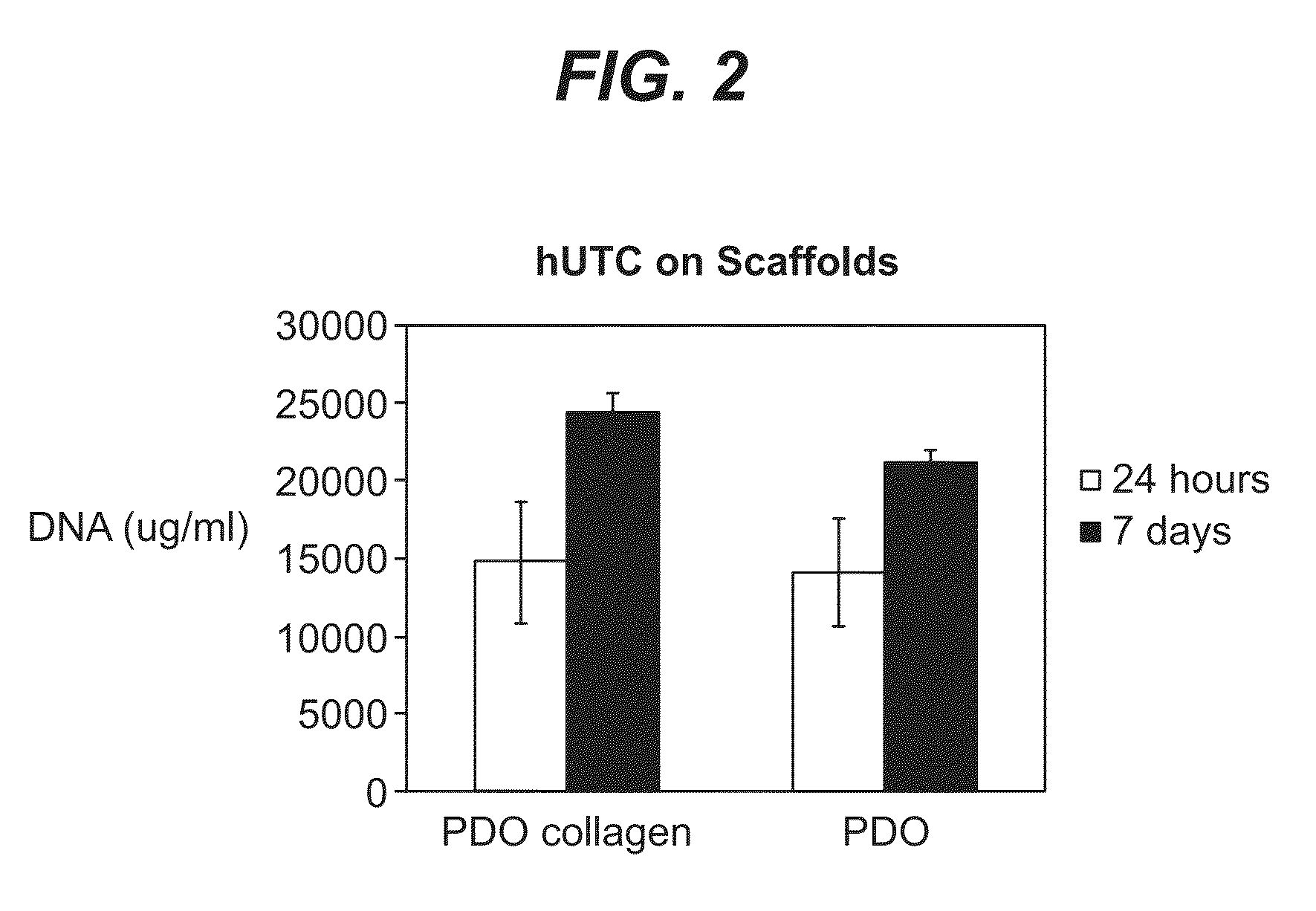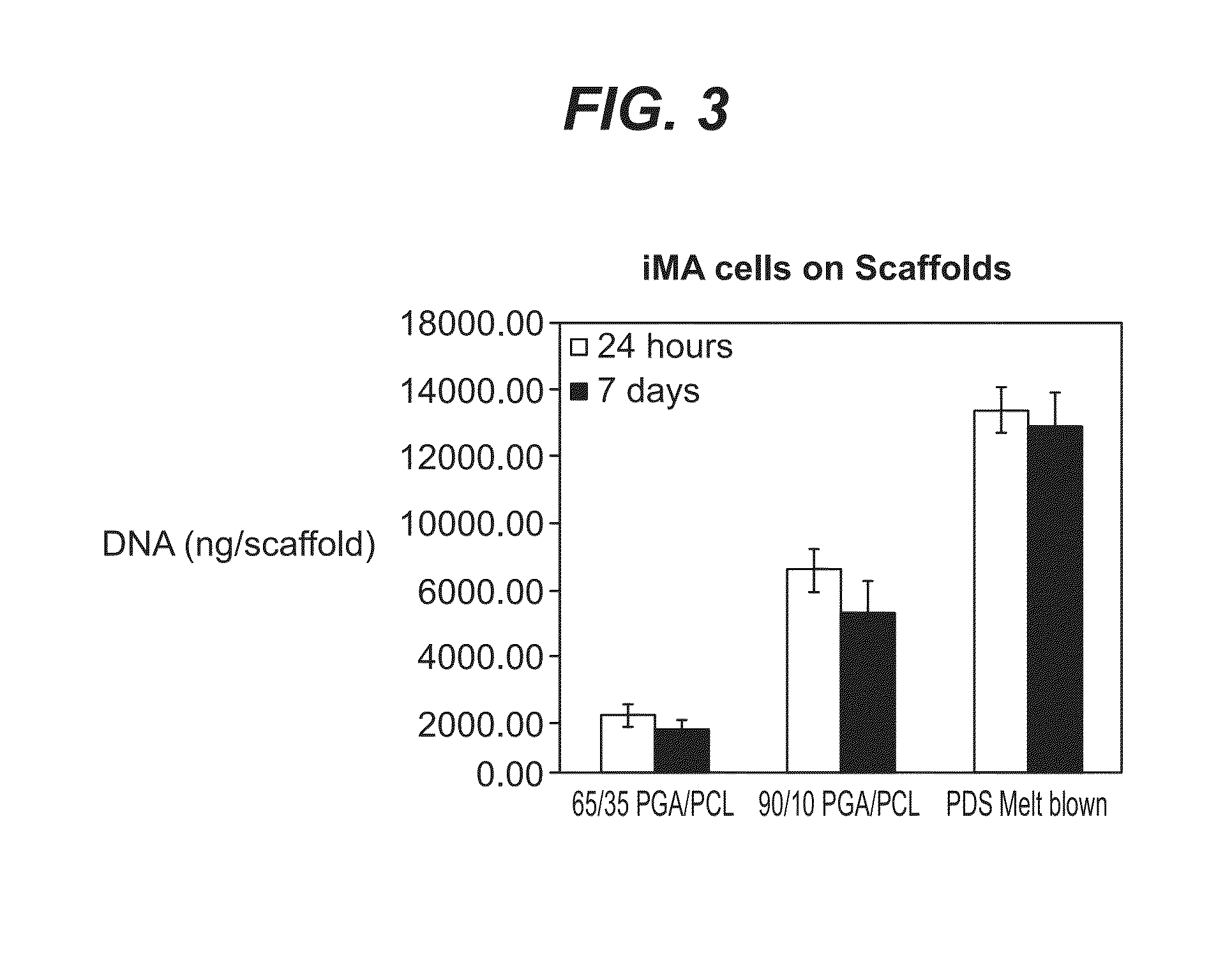Segmented, epsilon-Caprolactone-Rich, Poly(epsilon-Caprolactone-co-p-Dioxanone) Copolymers for Medical Applications and Devices Therefrom
a technology of epsilon caprolactone and copolymer, which is applied in the field of new semicrystalline, epsilon caprolactonerich block copolymer of epsilon, can solve the problems of cardiovascular-related disorders, unsuitable long-term implants, and relative difficulty in suture handling, and achieves the effect of improving the safety and safety of patients
- Summary
- Abstract
- Description
- Claims
- Application Information
AI Technical Summary
Benefits of technology
Problems solved by technology
Method used
Image
Examples
example 1
Synthesis of Segmented p-Dioxanone-Rich Poly(epsilon-caprolactone-co-p-dioxanone) Triblock Copolymer at 17 / 83 by Mole
[0123]Using a 10-gallon stainless steel oil jacketed reactor equipped with agitation, 4,123 grams of epsilon-caprolactone was added along with 63.9 grams of diethylene glycol and 16.6 mL of a 0.33M solution of stannous octoate in toluene. After the initial charge, a purging cycle with agitation at a rotational speed of 6 RPM in an upward direction was conducted. The reactor was evacuated to pressures less than 550 mTorr followed by the introduction of nitrogen gas. The cycle was repeated once again to ensure a dry atmosphere. At the end of the final nitrogen purge, the pressure was adjusted to be slightly above one atmosphere. The vessel was heated by setting the oil controller at 195° C. at a rate of 180° C. per hour. The reaction continued for 6 hours and 10 minutes from the time the oil temperature reached 195° C.
[0124]In the next stage, the oil controller set poin...
example 2
Synthesis of Segmented p-Dioxanone-Rich Poly(epsilon-caprolactone-co-p-dioxanone) Triblock Copolymer at 9 / 91 by Mole (PDO-Rich Cap / PDO copolymer)
[0127]Using a 10-gallon stainless steel oil jacketed reactor equipped with agitation, 2,911 grams of epsilon-caprolactone was added along with 90.2 grams of diethylene glycol and 23.4 mL of a 0.33M solution of stannous octoate in toluene. The reaction conditions in the first stage were closely matched those in Example 1.
[0128]In the second, copolymerization stage, the oil controller set point was decreased to 120° C., and 32,089 grams of molten p-dioxanone monomer was added from a melt tank with the agitator rotating at 7.5 RPM in a downward direction for 40 minutes. The oil controller was then set to 115° C. for 20 minutes, then to 104° C. for one hour and 45 minutes, and finally to 115° C. 15 minutes prior to the discharge. The post curing stage (80° C. / 4 days) and grounding and sieving procedure were conducted according to Example 1. The...
example 3
Synthesis of Segmented epsilon-caprolactone-Rich Poly(epsilon-caprolactone-co-p-dioxanone) Triblock Copolymer at 91 / 9 by Mole (Cap-Rich Cap / PDO copolymer) [Initial Feed Charge of 75 / 25 Cap / PDO]
[0130]Using a 10-gallon stainless steel oil jacketed reactor equipped with agitation, 18,492 grams of epsilon-caprolactone was added along with 19.1 grams of diethylene glycol and 26.2 mL of a 0.33M solution of stannous octoate in toluene. After the initial charge, a purging cycle with agitation at a rotational speed of 10 RPM in a downward direction was initiated. The reactor was evacuated to pressures less than 500 mTorr followed by the introduction of nitrogen gas. The cycle was repeated once again to ensure a dry atmosphere. At the end of the final nitrogen purge, the pressure was adjusted to be slightly above one atmosphere. The rotational speed of the agitator was reduced to 7 RPM in a downward direction. The vessel was heated by setting the oil controller at 195° C. at a rate of 180° C....
PUM
| Property | Measurement | Unit |
|---|---|---|
| glass transition temperature | aaaaa | aaaaa |
| absorption time | aaaaa | aaaaa |
| Young's modulus | aaaaa | aaaaa |
Abstract
Description
Claims
Application Information
 Login to View More
Login to View More - R&D
- Intellectual Property
- Life Sciences
- Materials
- Tech Scout
- Unparalleled Data Quality
- Higher Quality Content
- 60% Fewer Hallucinations
Browse by: Latest US Patents, China's latest patents, Technical Efficacy Thesaurus, Application Domain, Technology Topic, Popular Technical Reports.
© 2025 PatSnap. All rights reserved.Legal|Privacy policy|Modern Slavery Act Transparency Statement|Sitemap|About US| Contact US: help@patsnap.com



